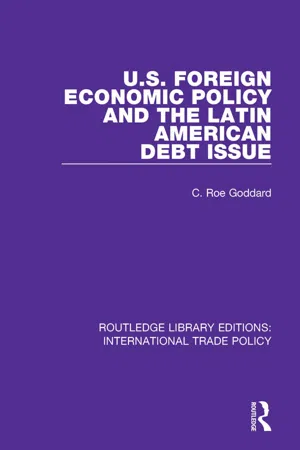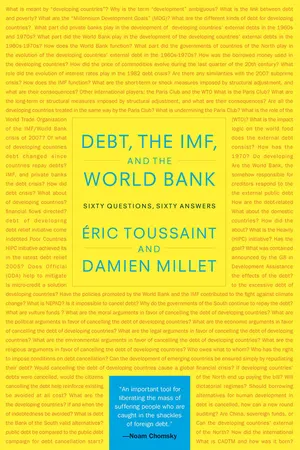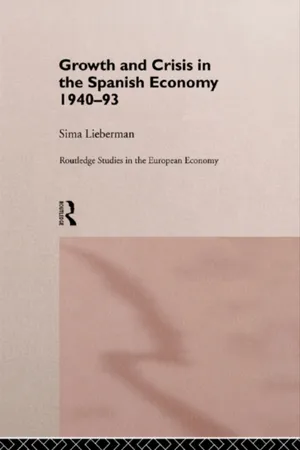Economics
The Debt Crisis of the 1980s
The Debt Crisis of the 1980s refers to a period when many developing countries were unable to meet their debt obligations, leading to a widespread financial crisis. The crisis was triggered by a combination of factors including high borrowing, economic mismanagement, and external shocks such as rising interest rates and falling commodity prices. It had significant implications for global financial markets and led to extensive restructuring efforts by international financial institutions.
Written by Perlego with AI-assistance
Related key terms
7 Key excerpts on "The Debt Crisis of the 1980s"
- C. Roe Goddard(Author)
- 2017(Publication Date)
- Routledge(Publisher)
Chapter 1The International Debt Crisis Enters the 1980s
The international debt crisis as it unfolded in the 1980s had a disastrous impact on the economies of the Latin American debtors. The debt problems of Mexico, Brazil and Argentina have wreaked havoc on their economies and dramatically reduced the standard of living of their populations. While there is widespread agreement concerning the results of the payments crises, there is considerable disagreement over the original causes.It is difficult to attribute the origins of the debt crisis to a single cause. Economics in general and international economics in particular lack the scientific precision that would allow us to recreate the debtor countries’ economic histories, distinguish among and assign weights to national and international economic and social factors, and rank these factors in terms of their positive or negative impacts on a country’s economic health. This inability to identify the causes of the debt crisis with scientific precision, let alone to reach an international consensus on how to address the debt problem, translates into an ongoing debate. The contending parties divide along ideological, national, and organizational lines.Even to catalogue the disparate views concerning the causes of the debt crisis is not an easy task. Classification schemes invariably lose much of the richness of the debate. However, for readers unfamiliar with the international debt issue and dynamics of the international financial marketplace as a whole, an exercise of this sort will serve a useful function. Although a virtually unlimited number of factors contributed to the debt problems of Mexico, Brazil and Argentina, they can be clustered into two general sets: national and international.National factorsMany observers emphasize the national economic policies adopted by the Latin American governments, both past and present, as the major source of the debt problem. Those adopting this position trace the seeds of the crisis back to the region's spectacular growth of the 1960s and the desire to maintain that level of growth in the changed international environment of the 1970s. In the period from 1950 until the quadrupling of oil prices in 1973, Latin America was able to achieve a relatively high level of growth. In fact, between the years 1950 and 1980, Latin America’s growth averaged 5.5 percent annually. By the mid-1960s, Latin America’s percentage of world trade hit previously unmatched levels, encouraging further expansion and diversification of the export sector. By the time of the 1973-74 oil crisis, Latin America’s growth rate was higher than that of the industrialized world.1- eBook - ePub
Debt, the IMF, and the World Bank
Sixty Questions, Sixty Answers
- Eric Toussaint, Damien Millet(Authors)
- 2010(Publication Date)
- Monthly Review Press(Publisher)
In August 1982, Mexico was the first country to announce that it was no longer able to repay. Other heavily indebted countries, such as Argentina and Brazil, followed. This was the debt crisis that rocked all the countries of the South, one after the other. Even countries of Eastern Europe were hit, especially Poland, and a little later Yugoslavia and Romania.The debt crisis resounded like a great clap of thunder. The international institutions, whose job it is to regulate the system and prevent crises, didn’t sound the alarm and acted as if everything was fine.It will be more difficult for developing countries to manage their debts, however, [current tendencies] do not indicate a general problem.—WORLD BANK, Global Development Report , 1981Although the World Bank and the IMF knew that clouds were gathering and a typhoon was forming, they didn’t want to advertise the real economic forecast. They wanted to give the major banks some time to pull out without harm.57 This was done with good reason, as the World Bank’s new president was none other than a former top man at one of the most important U.S. private banks, Bank of America, which had lent an arm and a leg to Mexico and Latin America.In short, the debt crisis had been caused by two phenomena, which occurred in quick succession: • an enormous increase in the amounts to be repaid, due to the sudden rise in interest rates decided in Washington;• an enormous price drop for products exported on the world market by the indebted countries, the proceeds of which were to repay their loans, and a halt in bank loans.58All the indebted countries in Africa and Latin America and several Asian countries (such as South Korea), regardless of the type of government, the degree of corruption or of democracy, were confronted with the debt crisis.The basic responsibilities are largely on the side of the industrialized countries, their central banks, their private banks, and their stock exchange (Chicago, London) that fix the prices of the raw materials. Corruption, megalomania, and the lack of democracy in the South (see Q10) certainly made matters worse but were not responsible for triggering - eBook - ePub
- Shirin M. Rai, Georgina Waylen(Authors)
- 2013(Publication Date)
- Routledge(Publisher)
ECONOMIC CRISES FROM THE 1980S TO THE 2010S
A gender analysis Diane Elson DOI: 10.4324/9781315884745-10Introduction
In August 1982 Mexico announced a moratorium on repayment of its international debts, and what became known as the Latin American debt crisis began. Latin America suffered a ‘lost decade’ and did not recover until into the 1990s. Many Asian countries were not affected and grew rapidly, but in 1997 there was an ‘Asian’ financial crisis, particularly affecting South Korea, Indonesia, Thailand and the Philippines. Growth recovered quite quickly but inequality widened. Just over a decade later, in 2008, there was a global financial crisis, followed in 2010 by a European debt crisis. Three decades after the Mexican moratorium, Greece is the country that cannot repay its debt, with Ireland, Portugal, Spain and Italy also facing repayment difficulties.This chapter looks at these crises through a gender lens, with particular focus on the financial liberalization that provoked these crises and the austerity policies that were prescribed as the remedy for them, drawing on both my earlier and more recent writings. I reflect on the evolution of my theoretical frames and the challenges of empirical substantiation of hypotheses that involve the unpaid as well as the paid economy.In relation to the Latin American debt crisis, I was concerned to challenge the account given by neoclassical economic theory of the impact of austerity, which only took account of the market economy and paid work. I developed a theoretical frame that also took account of the impact on the non-market economy and unpaid work, and argued that the policymakers’ assumption of a relatively smooth reallocation of resources and resumption of economic growth depended on a hidden implicit assumption that women’s supply of labour was perfectly elastic. In relation to the Asian financial crisis, I extended my frame to include the development of the crisis through the liberalization of the financial system, and the creation and distribution of risks, highlighting the way in which women were implicitly called upon to provide the safety net of last resort. In relation to the European debt crisis, I developed a frame that could more fully take into account the gendered character of the spheres of finance, production and reproduction. Throughout the development of these frames, I was concerned to highlight the gender biases in policies that on the surface might appear to be gender neutral and to contextualize the accounts given by neoclassical economics. - eBook - ePub
- Ensar Yılmaz(Author)
- 2020(Publication Date)
- Routledge(Publisher)
As the figure presents, default periods occurred in clusters, corresponding to successive expansion of lending and increasing large capital inflows. In the 20th century, the advanced countries faced defaults only during the Great Depression and the Second World War. However, throughout the 20th century, the frequency of defaults in particularly developing countries increased too much and after these crises they struggled to obtain funds from foreign capital markets for several years. Developing countries, especially Latin countries, experienced a wave of sovereign defaults in the early 1980s. The number of sovereign debts in default also peaked in the 1990s; for example, the Russian sovereign debt crisis in 1998. More recently the European sovereign debt crisis of 2009–2012 occurred.Since the Second World War, the issue of sovereign default has been mainly associated with developing countries. The third-world debt of the 1980s was the biggest. The banks in the developed countries had expanded their credits in the 1970s, in part by recycling the surpluses generated by the oil-exporting nations. Increased oil prices increased the revenues of oil-producing countries in the 1970s. These countries gave more loans to governments and state companies in Latin-economic countries such as Mexico, Brazil, Argentina, and other developing countries. The foreign debt of these countries increased tremendously. With this foreign money, they financed their large trade deficits.However, Mexico and other developing countries met with unpleasant developments, for example, the interest rates charged to them increased in the international capital markets and their export revenue declined drastically. Hence Mexico could not meet its debt repayments and the crisis quickly spread to the rest of Latin America, such as Brazil and Argentina at the beginning of the 1980s. The US banks were exposed to heavy losses. But the so-called Brady plan (named after the US Treasury Secretary Nicholas Brady) came to the rescue. It allowed banks to exchange their illiquid holdings of Latin American debt into more liquid instruments, backed by US Treasury bonds. The Brady bonds in 1989 and 1990 provided an opportunity for these countries to convert their bank loans with the US treasury bonds. This allowed them to access the global finance markets again. - eBook - ePub
Global Political Economy
Theory and Practice
- Theodore H. Cohn, Anil Hira(Authors)
- 2020(Publication Date)
- Routledge(Publisher)
37 At the UNCTAD V conference in 1979 the G77 sought to replace the Paris and London Clubs with an international debt commission more attuned to LDC interests. Although the creditor governments agreed to invite an UNCTAD observer to future Paris Club negotiations, it refused to create such a commission. Thus, the creditors continue to set the rules and procedures for Paris and London Club negotiations.Strategies to Deal With the 1980s Debt Crisis
The debt crisis was more prolonged than expected, and the creditor states and international institutions adopted more activist strategies when milder measures proved to be insufficient. Although the IMF had lost some importance with the collapse of the pegged exchange rate system and the increase in private bank lending in the 1970s, the 1980s debt crisis put it “back at the center of the international financial system, first as a coordinator in a crisis, and then … as a source of information, advice, and warning on the mutual consistency of national policies.”38 The IMF’s central role stemmed largely from the U.S. view that multilateral institutions could best implement DC policies on debt issues. The IMF also could put pressure on LDC debtors and private banks without causing major protests over U.S. government interference. When G7 summit meetings began to address international debt issues in the late 1980s, the major economic powers to a degree replaced U.S. hegemony with collective responsibility for LDC debt problems.39The international debt strategies had three major goals: to prevent the collapse of the international banking system, to restore capital market access for debtor countries, and to restore economic growth in debtor states. The strategies to achieve these goals can be divided into four phases: - eBook - ePub
- Duncan Connors(Author)
- 2016(Publication Date)
- University of Wales Press(Publisher)
The effects quickly spread to reduce the borrowing powers of LDCs elsewhere, so that by the spring of 1983 some twenty-five LDCs with debts comprising two-thirds of the LDC total had been forced to enter rescheduling negotiations with their bankers, while many of them were completely cut off from new banking funds. ‘It is not easy to escape the conclusion,’ said the Bank for International Settlements, ‘that international borrowing since 1974 has not been very advantageous to the debtor countries, although a good part of it was an inevitable product of two major rounds of oil price increases’ (BIS Annual Report, 1983, 130). The lending bankers found their balance sheets under strains of unaccustomed severity, but sauve qui peut attitudes would only make things worse for other bankers as well as for the borrowers. Consequently in the ten years following the Mexican crisis a whole series of co-operative ventures were arranged, involving the debtor governments, the international agencies (IMF and World Bank etc.) plus the governments of the industrial countries and the lending bankers. Because of the prominence of American interests, the lead in such negotiations was first given by the US Treasury Secretary, James Baker, in October 1985, followed up by a modified and improved version by his successor, Nicholas Brady, in March 1989. While the details of these various initiatives differ, they offered combinations of debt forgiveness, debt lengthening, interest-free interludes, equity swaps, sales of discounted debt on secondary markets, and so on - Sima Lieberman(Author)
- 2005(Publication Date)
- Routledge(Publisher)
The appreciation of the US dollar and high rates of interest proved to be catastrophic for most developing nations. Since the beginning of 1980, a number of dramatic changes in the world economy seriously damaged the economies of the developing countries. Among these changes were the appreciation of the US dollar, the continuing recession in the industrializing nations, the rapid rise of interest rates in the world’s financial markets, the decline in the volume of world trade and the resulting fall of the international prices of primary commodities. From mid–1982, a number of developing countries had to announce their inability to service their external debts and the possibility that they would have no other alternative but to repudiate the latter. Indeed, the ability of these countries to pay interest or principal on such debts had been seriously impaired since 1980 by a concurrent decline of the quantities and the prices of their exports. On the other hand, rising interest rates in world financial markets increased the difficulty of servicing their external debts. The fall in the volume of their exports was mainly due to the deterioration of economic activity in the economically advanced nations. Falling prices of primary commodities, the chief export of most developing nations, weakened the ability of the latter to earn the foreign exchange they needed to remain externally solvent. The external solvency of the developing nations ultimately depended on the ability of the industrialized nations to overcome their internal economic crises and to import more commodities from the developing nations.In the 1960s, industrialized countries exporting manufactured goods started facing the new competition offered by the NICs in years marked by a slowdown in technological advance. The early 1970s brought an end to the general boom period caused by the reconstruction and development activities which followed the end of World War II, and the collapse of the Bretton Woods international monetary system which was replaced by highly unstable international monetary arrangements. The two energy crises of that decade unleashed recessions throughout the Western world which seriously impeded the resumption of adequate economic growth in the industrialized nations. In view of these changes, a necessary adjustment of the advanced economies required restructur-ing of their industrial sectors in favour of high-technology production to reduce competition with the NICs producing low- or mediumtechnology products. Such industrial transformation was however ren-dered difficult because world markets for high-technology goods were narrow. Worldwide recession was another major impediment to such industrial reconstruction.
Learn about this page
Index pages curate the most relevant extracts from our library of academic textbooks. They’ve been created using an in-house natural language model (NLM), each adding context and meaning to key research topics.






